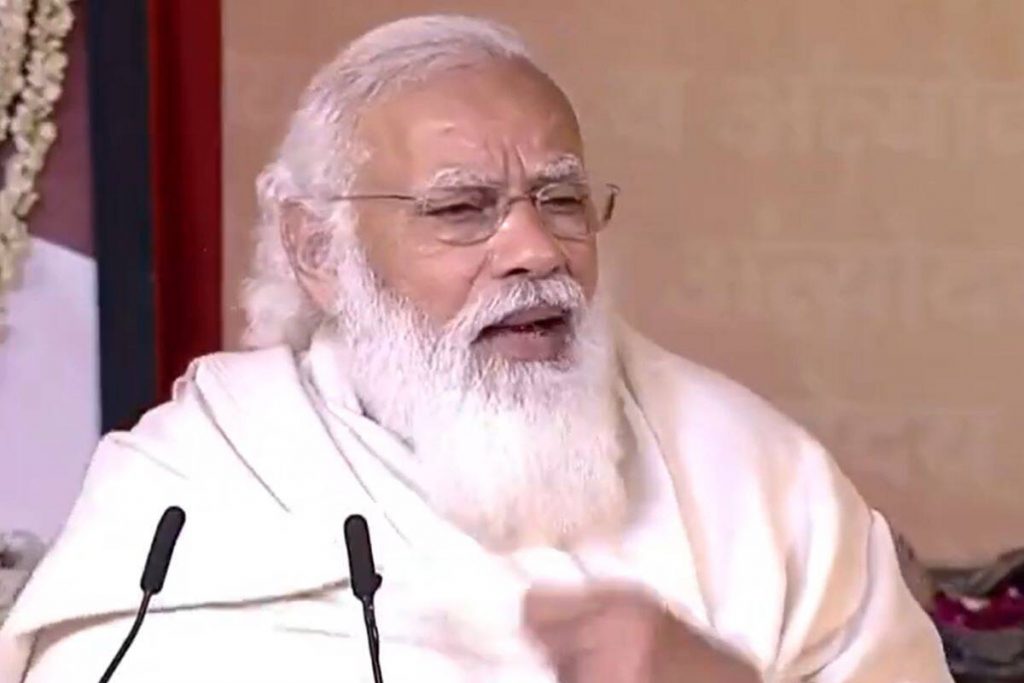Manas Dasgupta
NEW DELHI, May 15: Amidst controversy that many states are under-reporting their cases and fatality tallies, the prime minister Narendra Modi on Saturday advised the states to ask their officers to report Covid-19 numbers transparently “without any pressure of high numbers showing adversely on their efforts.”
The Prime Minister showed concern over the reports about ventilators lying unutilised in some states and directed that an immediate audit of installation and operation of ventilators provided by the Centre should be carried out. Modi also stressed on the need of localised containment strategies in areas where the positivity rate is high.
“The Prime Minister added that refresher training for properly operating ventilators should be provided to healthcare workers if necessary,” an official statement read.
As India continued to show downward trend, though marginally, in recording daily new cases on Saturday, Modi chaired a high-level meeting to take stock of the Covid-19 situation in the country. Modi called for augmenting healthcare resources in rural areas to focus on door to door testing and surveillance, and asserted that localised containment strategies are the need of the hour, especially in states with high positivity rate in districts.
Modi also directed that a distribution plan for ensuring oxygen supply in rural areas should be worked out, including through provision of oxygen concentrators, a statement from the Prime Minister’s Office (PMO) said.
He said necessary training should be provided to health workers in the operation of such equipment, and power supply should be ensured for smooth operation of such medical devices. Unlike the first wave of COVID-19 cases last year when rural India was not badly hit, the region has been seriously affected by the second wave in several states.
Modi sought empowering ASHA and anganwadi workers with all necessary tools.
Testing needs to be scaled up further, with use of both RT-PCR and rapid tests, especially in areas with high test positivity rates, he added.
Modi was briefed about the gradually decreasing test positivity rate and increasing recovery rate, it said, adding that cases had gone over four lakh per day and are now coming down as a result of the efforts of healthcare workers, state governments and the central government.
Officials gave a detailed presentation on the state and district level situation of COVID-19 testing, oxygen availability, healthcare infrastructure and vaccination roadmap.
During the course of the meeting, the Prime Minister was informed that tests have gone up significantly across the country — from around 50 lakh tests per week in early March to around 1.3 crore tests per week now.
Regarding vaccination, the Prime Minister asked officials to work closely with the state governments to speed-up inoculation drives across the country.
Meanwhile, on Saturday India in a day recorded 3,26,098 COVID-19 cases that took the tally to 2,43,72,907, while 3,890 new fatalities pushed the death toll to 2,66,207, according to Union health ministry data.
The active cases have reduced to 36,73,802 and comprise 15.07% of the total infections, while the national COVID-19 recovery rate has improved to 83.83%, it stated. The number of people who have recovered from the disease has increased to 2,04,32,898, while the case fatality rate stands at 1.09%, the data updated at 8 a.m. showed.
The health joint secretary Lav Agarwal said 11 States have over 1 lakh active cases, 17 have less than 50,000 cases. There are 24 States with more than 15% positivity. There are 516 districts with over 10% positivity.
“18.04 crore doses of vaccine have been administered so far.”
The NITI Aayog member VK Paul said urged the people not to raise controversy over changes suggested for gap between the two vaccine doses.
“There are narratives that say the dosages between vaccines were extended because of shortage. This is false.
“We have independent scientists. When UK extended dosage, we had evaluated the data available at that time and decided that the evidence didn’t support extending time gap. We were worried about breakthrough infections.
“The situation now is that, after evaluating data from the U.K. experience, it was 60-85% effective in disease prevention. The data also says that it showed a halt in transmission. Thus with this evidence we have decided that we can delay gap between doses. We are following scientific protocol on how data is to be interpreted. So please respect our scientists’ decisions.
Pointing out that the pandemic was “in a mixed stage,” Paul said the trend seems to be towards stabilisation.
“Case fatality rate is stable, and this is a big achievement. This is due to the collective work of districts, States and the country.
“We have on some days done 1.9 million tests. This is a world record and no country has ever achieved that. This while ensuring that 70% is RT-PCR,” he said.
He said the vaccine technology transfer was a complex issue. “From seed to production, it takes about 70-75 days. Bharat Biotech has tied up with 3 PSUs and working with them for many months and is not something that started to be discussed just few weeks ago.
“All vaccine manufacturers consider Indian government as partners,” he added.

